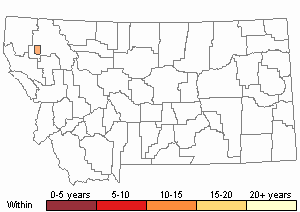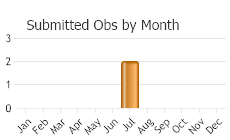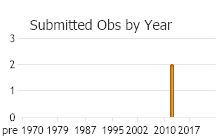View in other NatureServe Network Field Guides
NatureServe
Montana
Utah
Wyoming
Idaho
Wisconsin
British Columbia
South Carolina
Yukon
California
New York
Bull Thistle Gall Fly - Urophora stylata
State Rank Reason (see State Rank above)
Urophora stylata was introduced from Germany and Switzerland into the United States of America (USA) in 1933 as a biocontrol agent to control non-native Bull Thistle (Cirsium vulgare) and create a balance between a plant species with their natural predator (Winston et al. 2012). The establishment of Urophora stylata in Montana has not been reported (Winston et al. 2012). A conservation status rank is not applicable (SNA) because Urophora stylata is a non-native insect in Montana that is not a suitable target for conservation activities.
General Description
Bull Thistle Gall Fly (Urophora stylata) is an insect, specifically a type of gall fly in the Family Tephritidae.
ADULTS: Brownish-gray bodies with a yellow head and brownish legs. Wings are clear. On each wing is a grey-brown ‘VI’ ‘IV’ shaped marking. Males grow to 5 mm and females to 7 mm long. Source: Winston et al. 2016
LARVAE: Off-white, barrel-shaped bodies, with a dark anal plate. They grow to 5 mm long. Source: Winston et al. 2016
Range Comments
Bull Thistle Gall Fly is native to Western Europe (Winston et al. 2012).
INTRODUCTION
Bull Thistle Gall Flies from Germany and Switzerland were released onto Bull Thistle (Cirsium vulgare) in British Columbia, Canada in 1973 (Winston et al. 2016). From Canada, insects were re-distributed to Bull Thistle into California, Colorado, Montana, Oregon, and Washington, USA, since 1983.
Observations in Montana Natural Heritage Program Database
Number of Observations: 2
(Click on the following maps and charts to see full sized version)
Map Help and Descriptions
Relative Density

Recency


 (Observations spanning multiple months or years are excluded from time charts)
(Observations spanning multiple months or years are excluded from time charts)
Habitat
Bull Thistle Gall Fly does best in open meadows where the host plants are scattered (Winston et al. 2016). Insects do not do as well where thistle stands are dense or sites that flood and have high winds.
HOST PLANTS
Bull Thistle Gall Fly feeds on Bull Thistle (Cirsium vulgare) (Winston et al. 2012 and 2016).
Food Habits
DAMAGE TO PLANTS [Adapted from Winston et al. 2016]
Bull Thistle Gall Fly predates on Bull Thistle.
Larvae reduce seed production in Bull Thistle by two methods: 1) Galls develop in response to larval feeds. Galls act as metabolic sinks, diverting resources away from normal plant development. 2) Where galls develop in flower heads, the seeds become physically stuck, preventing seed dispersal.
Reproductive Characteristics
LIFE CYCLE [Adapted from Winston et al. 2012]
Bull Thistle Gall Fly produce one generation per year. Larvae overwinter in galls which pupate in early spring. Adults emerge in early summer. Adults deposit eggs in on the plant's maturing buds. Larvae hatch and burrow into flower heads to feel on seed-producing tissue. This feeding induces the development of galls. Multiple larvae can be found in a single flower head. Larvae develop through three stages (instars). Most larvae overwinter in their 3rd instar. Larvae that mature early may pupate in early summer as a 2nd generation.
Management
BIOLOGICAL CONTROL [Adapted from Winston et al. 2012 and 2016)
Bull Thistle Gall Fly is an insect species brought into the USA to control the non-native Bull Thistle plant. A fair amount of preliminary work and an array of factors must be considered when developing a biocontrol plan for controlling non-native thistles. Readers are encouraged to consult the "Useful Links" and cited literature in this profile.
Bull Thistle Gall Fly feeds on Bull Thistle (
Cirsium vulgare). It can be difficult to maintain large populations of Bull Thistle Gall Fly because Bull Thistle is often short-lived (Winston et al. 2016). In the USA the abundance of this insect and its impact on Bull Thistle vary greatly (Winston et al. 2016). In Oregon the insect's populations are cyclical. In California, Colorado, and Washington, populations are limited. Where 60-90% of flower heads are attacked, 60% of seed production was reduced. However, in Canada the insect has naturally dispersed to become abundant (Winston et al. 2016). Bull Thistle populations at most sites have decreased, which is likely due to a combination of factors with land management use and attacks by Bull Thistle Gall Fly and Thistle Seedhead Weevil (
Rhinocyllus conicus).
Melissa Maggio-Kassner is the coordinator for the Montana Biological Weed Control Project. She can be reached at (406) 258-4223 or
mmaggio@missoulaeduplace.orgUseful Links:Montana Invasive Species websiteMontana Biological Weed Control Coordination Project Field Guide for Biological Control of Weeds in Montana Montana Department of Agriculture - Noxious WeedsMontana Weed Control AssociationMontana Weed Control Association Contacts Webpage.
Montana Fish, Wildlife, and Parks - Noxious WeedsMontana State University Integrated Pest Management ExtensionWeed Publications at Montana State University Extension - MontGuides
Stewardship Responsibility
References
- Literature Cited AboveLegend:
 View Online Publication
View Online Publication Winston, Rachel L., Carol Bell Randdall, Rosemarie De Clerck-Floate, Alec McClay, Jennifer Andreas, and Mark Schwarzlander. 2016. Field Guide For The Biological Control of Weeds In The Northwest. August 2016 Reprint. FHTET-2014-08. Forest Health Technology Enterprise Team, University of Idaho Extension and USDA Department of Agriculture.
Winston, Rachel L., Carol Bell Randdall, Rosemarie De Clerck-Floate, Alec McClay, Jennifer Andreas, and Mark Schwarzlander. 2016. Field Guide For The Biological Control of Weeds In The Northwest. August 2016 Reprint. FHTET-2014-08. Forest Health Technology Enterprise Team, University of Idaho Extension and USDA Department of Agriculture. Winston, Rachel, Rich Hansen, mark Schwarzlander, Eric Coombs, Carol Bell Randall, and Rodney Lym. 2012. Biology and Biological Control of Exotic True Thistles. Third Edition, April. FHTET-2007-05. Forest health Technology Enterprise Team, USDA, US Department of Agriculture.
Winston, Rachel, Rich Hansen, mark Schwarzlander, Eric Coombs, Carol Bell Randall, and Rodney Lym. 2012. Biology and Biological Control of Exotic True Thistles. Third Edition, April. FHTET-2007-05. Forest health Technology Enterprise Team, USDA, US Department of Agriculture.
- Web Search Engines for Articles on "Bull Thistle Gall Fly"
- Additional Sources of Information Related to "Insects"





